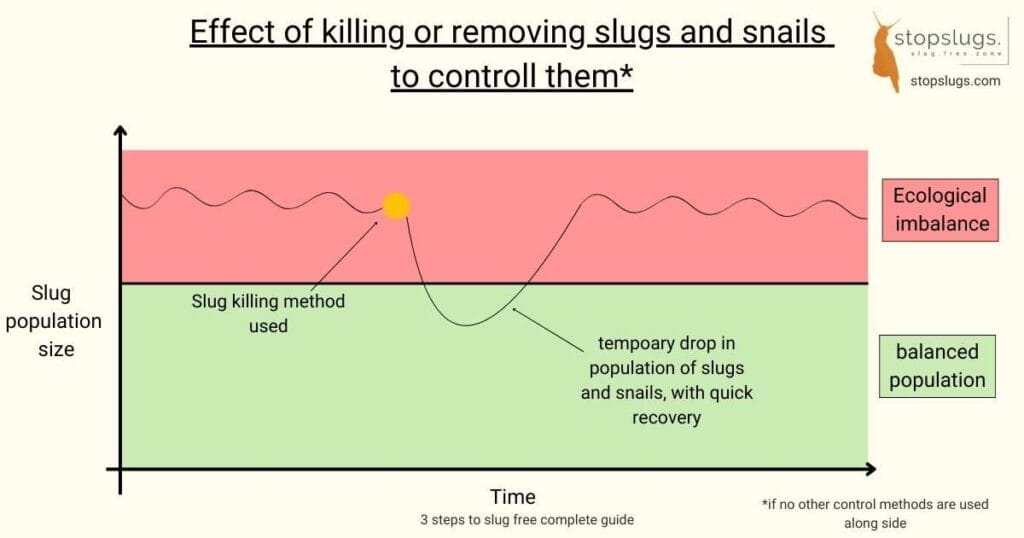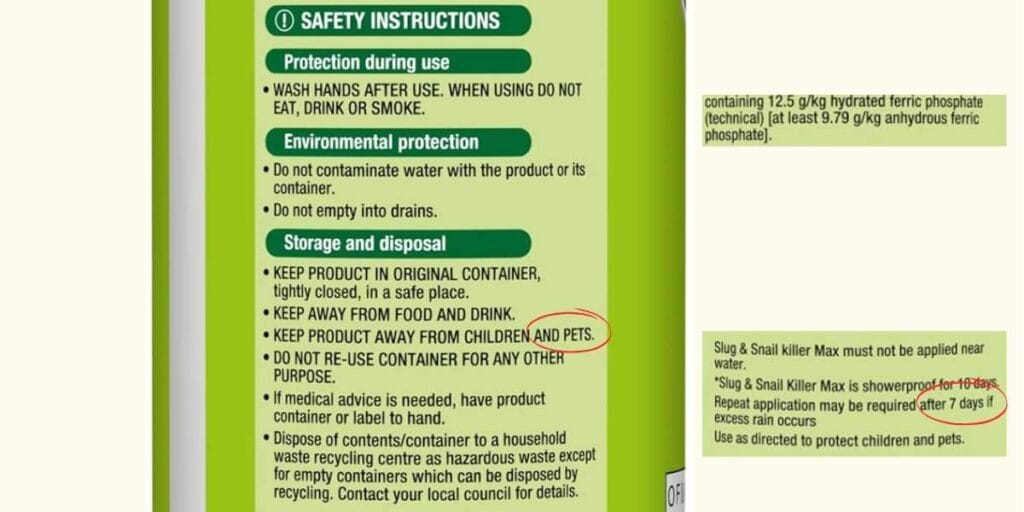Understanding snail bait / snail pellets

The first thing I want you to understand about snail bait, usually in the form of pellets is that it can’t solve your snail and slug problem on its own. One snail can lay up to 600 eggs multiple times a year, meaning you’ll quickly find yourself right back where you started—reaching for more snail bait and constantly reapplying it, especially since rain can wash it away. To achieve lasting results, you need a more comprehensive approach to garden management. Otherwise, you’ll just get caught in a cycle of buying more product for only temporary relief.
Slugs and snails are in your garden because it offers an ideal environment for them to thrive. Simply using snail bait or other products to kill them won’t address the root cause in the long term.
Before we go on and tell you about the two main types of snail bait iron phosphate and metaldehyde I highly recommend checking out our detailed 3-step guide to creating a slug-free garden. In it, we explain our reasoning for ranking barriers and repellents the way we do from best to worst, and offer a clear, actionable plan to address the issue effectively:

What other snail control methods should be used before snail bait
We recommend using snail pellets only after you’ve considered implementing the actions from Step 1 and Step 2 of our 3 Steps to a Slug-Free Garden guide. Alternatively, you can implement all three steps at the same time, but be sure that snail pellets are not the only solution you rely on.
Step 1: Managing the Environment – These cost-effective, long-term solutions focus on making your garden less hospitable for slugs, preventing them from thriving.
Step 2: Implementing Barriers and Repellents – Discover which methods are most effective and how to apply them properly. Avoid wasting time on myths—we’ve tested and proven what works, so you don’t have to!
Step 3: Selecting the Best Slug killing Method (including snail bait pellets) – Here, we outline which approaches work best and which are pet friendly which is of course important for people that own dogs and cats in particular.
By following these steps, you’ll address the root cause of your slug problem rather than just managing the symptoms. and you can read that guide by clicking the button below:

snail bait: types, effectiveness, and risks to pets and wildlife
Snail bait is designed to attract and eliminate snails by using an active ingredient that is toxic to them. The two most common types are metaldehyde and iron phosphate, each with different effects on snails, pets, and the environment.
types of snail pellet
1. Metaldehyde Snail Bait (Banned in many european countries)
Metaldehyde has been widely used in agriculture and gardening due to its effectiveness in killing snails. However, it poses a serious risk to pets, wildlife, and water sources.
- Metaldehyde snail bait is banned in the UK amongst others due to environmental risks.
- Highly toxic to birds, hedgehogs, and pets if ingested.
- Should not be used near water sources as it contaminates soil and waterways.
- Typically blue or green in color to attract snails.
2. Iron Phosphate Snail Bait (Safer Alternative)
Iron phosphate is a legal, safer alternative that works by disrupting the snail’s digestive system, leading to death within 3-6 days.
- Less toxic to pets and wildlife, but can be harmful to earthworms.
- Usually beige or brown in color and blends with soil.
- Unlike metaldehyde, it doesn’t stop slime production, so snails may crawl away before dying.
How to use snail pellets
To use snail bait effectively, start by applying the pellets around the areas where you’ve observed the most snail activity. Place the bait in damp, sheltered spots where snails tend to hide, such as under garden pots, along fences, or in dark, moist corners. Be sure to follow the recommended application amount, as overuse can be wasteful and may harm non-target species.
Timing is also important. Apply the snail bait in the evening when snails are most active and temperatures are cooler. Avoid using the bait right before or during rain, as it can wash away. Keep an eye on the results and reapply if necessary, especially after heavy rain.
summary
Snail pellets can be a useful tool in your garden shed, but they won’t provide long-term effectiveness. Their primary benefit is in offering short-term relief, particularly during vulnerable periods like spring when plants are most at risk. They should be used as part of a broader, comprehensive snail control plan rather than as the sole solution.
